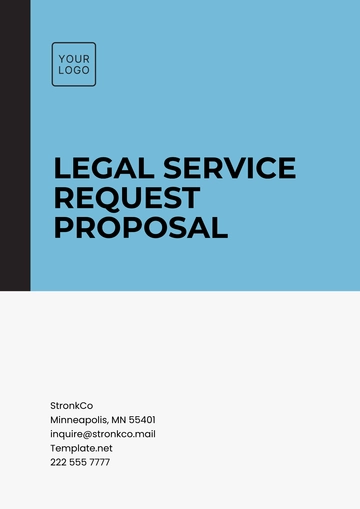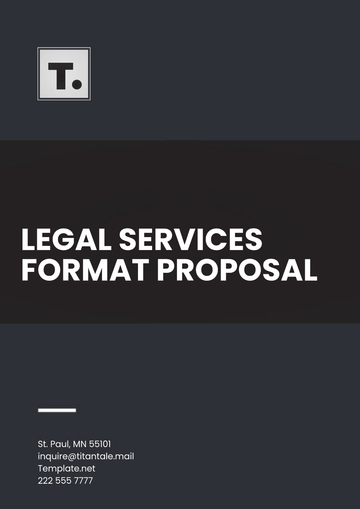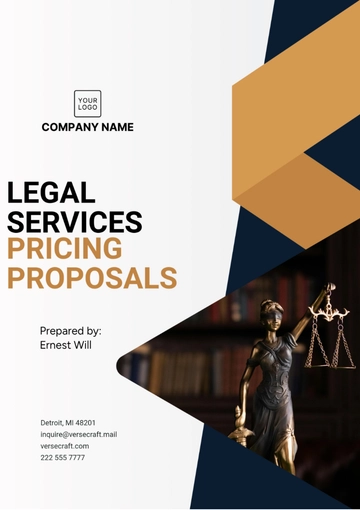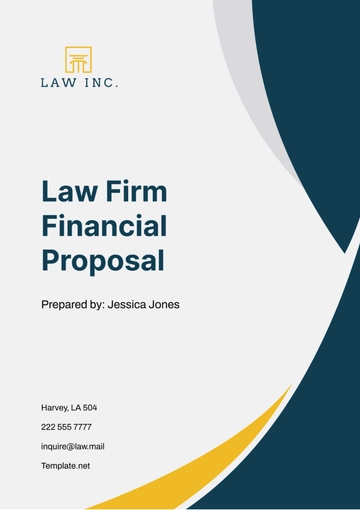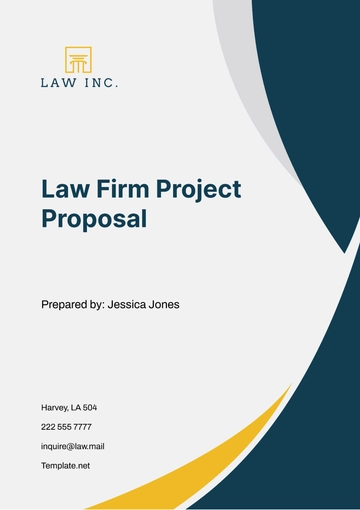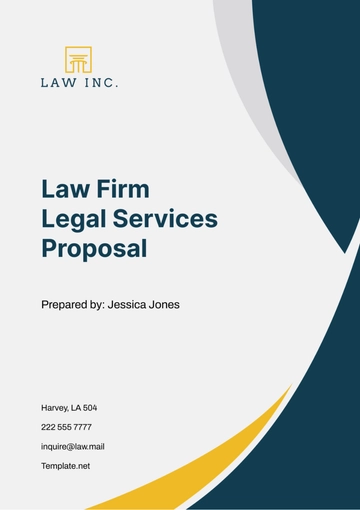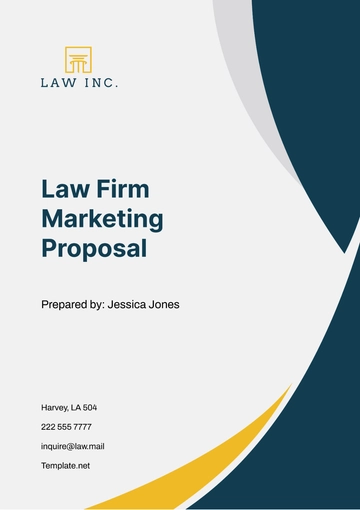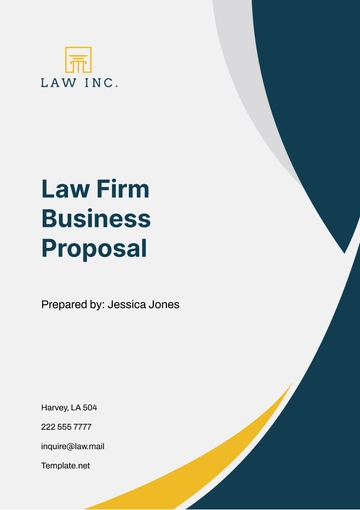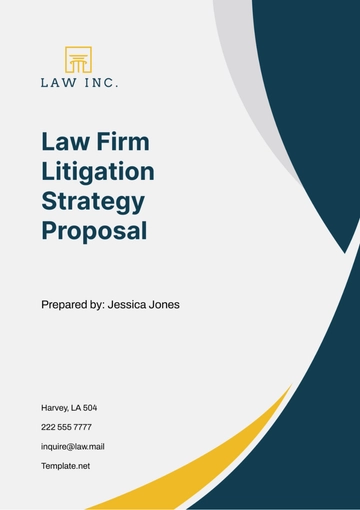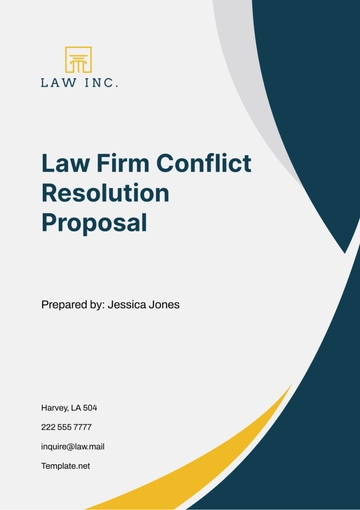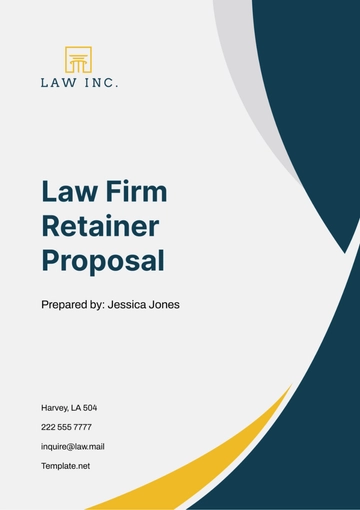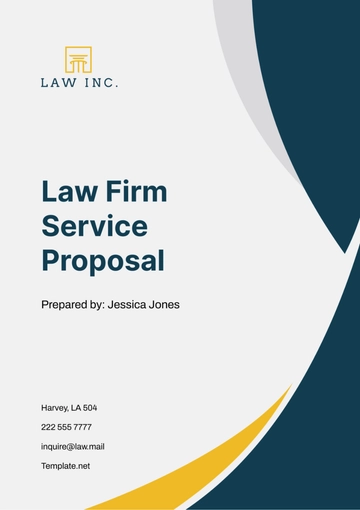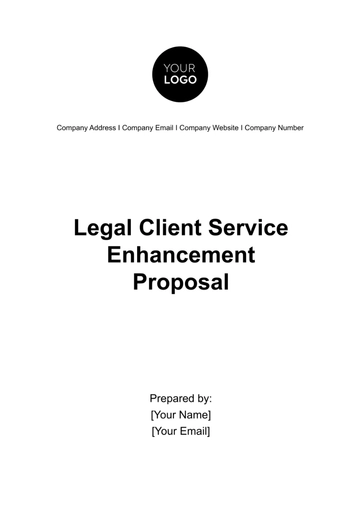Free Law Firm Marketing Proposal
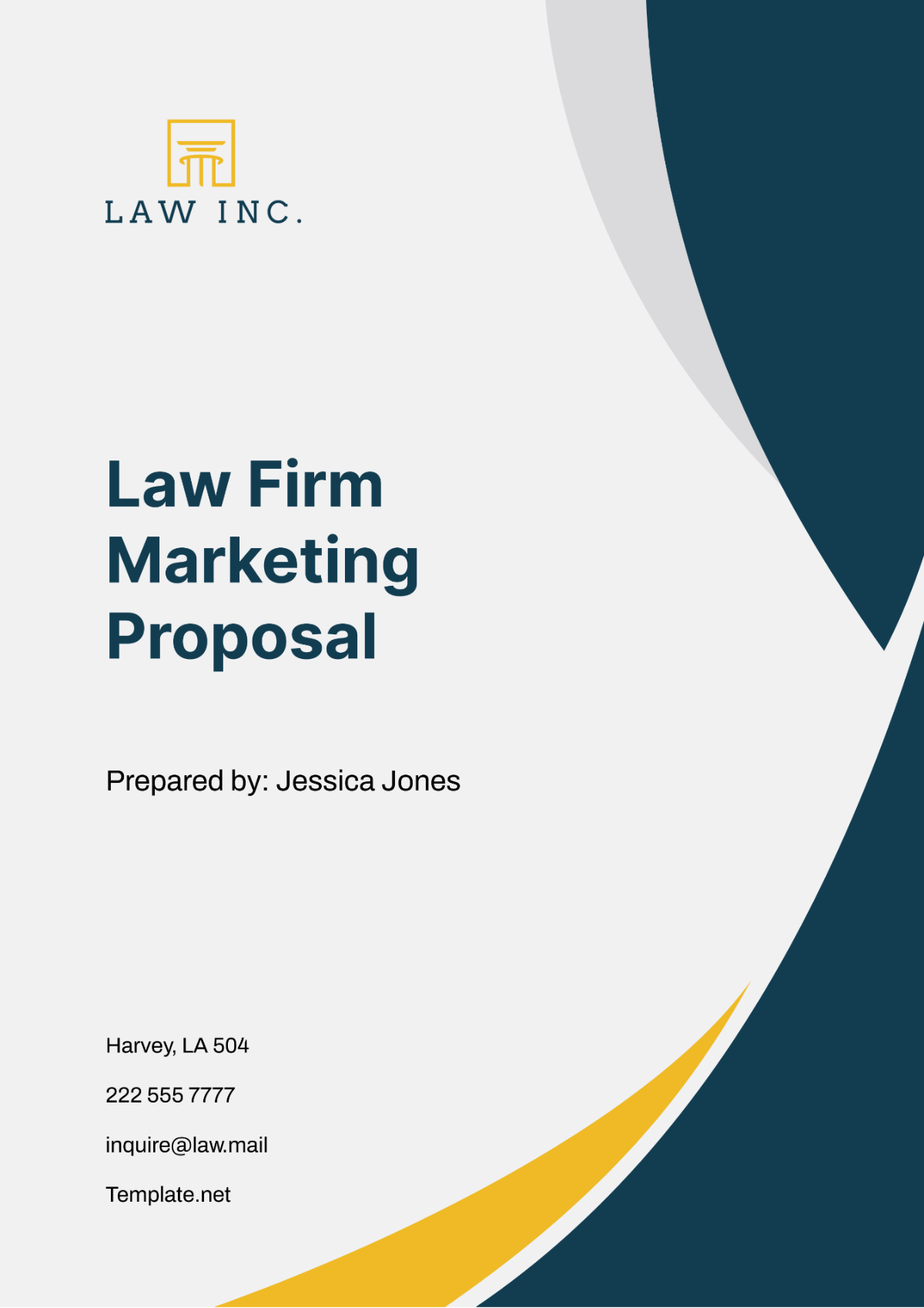
I. Executive Summary
This proposal outlines a comprehensive and strategic marketing plan tailored specifically for [Your Company Name]. The primary objectives are to enhance brand recognition, expand our client base, and improve client retention. We aim to establish our law firm as an industry leader by leveraging innovative marketing strategies.
The proposed marketing strategy is based on a thorough understanding of the current legal market trends, client needs, and our firm’s position in the industry. It involves conducting comprehensive market research, developing a new brand strategy, implementing digital marketing strategies, improving client engagement, and tracking performance metrics. The marketing strategies will be implemented across various platforms, both digital (website, social media, emails) and traditional (event sponsorships, print advertisements), with a primary focus on attracting new clients while nurturing existing client relationships.
The proposal also provides a detailed timeline and budget for the implementation of the marketing plan. It acknowledges the potential risks associated with the plan and provides mitigation strategies to manage these risks effectively. The successful implementation of this proposal will yield significant benefits, including increased revenue, cost efficiency, sustainable growth, competitive advantage, and client value. It will also enhance our firm’s reputation, increase its visibility in the market, strengthen its brand identity, build trust with clients, and improve its position in the legal market.
II. Introduction
A. Background
The legal industry is a dynamic and competitive environment. With the rise of digital technology and changing client expectations, law firms are compelled to adapt and innovate. Our firm, [Your Company Name], recognizes these challenges and sees them as opportunities for growth and improvement. [Your Company Name] has established a solid reputation in the legal industry. However, to maintain our competitive edge, we must continuously evolve and adapt to the changing market landscape. This proposal is a strategic response to these industry shifts.
A well-crafted marketing strategy is crucial in navigating the competitive legal industry. It will guide our efforts in enhancing our brand, expanding our client base, and improving our services. This proposal aims to outline a comprehensive marketing plan tailored specifically for [Your Company Name]. It presents innovative strategies designed to position our firm as a leader in the industry. The successful implementation of this proposal requires the collective effort of all stakeholders. We believe that with everyone’s commitment and participation, we can transform this vision into reality.
B. Objectives
The objectives of this proposal are:
Increase Overall Market Visibility: We aim to enhance our firm’s presence in the market through targeted marketing campaigns. By increasing our visibility, we can attract more potential clients and establish our firm as a top-of-mind choice in the legal industry.
Improve Client Engagement Through Digital Platforms: Digital platforms offer a convenient and efficient way to communicate and engage with clients. We plan to leverage these platforms to foster better relationships with our clients and improve their experience with our firm.
Develop a Stronger Brand Identity: A strong and distinctive brand can set our firm apart from competitors. We aim to create a compelling brand that resonates with our target audience and reflects our firm’s values and expertise.
Generate More Leads and Convert Them into Clients: Attracting potential clients is just the first step. We also need to implement strategies that will convert these leads into loyal clients. This involves understanding their needs and providing legal services that meet these needs.
III. Methodology
A. Market Research
Industry Analysis: We will conduct a thorough analysis of the current legal market trends. This will involve studying our competitors, understanding the needs of our target audience, and identifying opportunities for growth. The insights gained from this analysis will guide our marketing strategies.
Client Needs Assessment: Understanding our clients’ needs is crucial in delivering effective legal services. We will conduct surveys and interviews to gather information about our clients’ preferences, expectations, and satisfaction levels. This data will inform our client engagement strategies.
Performance Benchmarking: We will benchmark our performance against industry standards and competitors. This will help us identify our strengths and areas for improvement, and set realistic and achievable goals.
SWOT Analysis: We will conduct a SWOT (Strengths, Weaknesses, Opportunities, Threats) analysis to understand our firm’s internal and external environment. This will guide our strategic planning process.
Market Segmentation: We will segment our market based on various factors such as demographics, psychographics, and legal needs. This will allow us to tailor our marketing strategies to each segment, improving their effectiveness.
B. Brand Revitalization
Brand Audit: We will conduct a brand audit to evaluate our current brand identity. This involves assessing our brand’s strengths, weaknesses, opportunities, and threats. The results of the audit will guide our brand revitalization efforts.
Brand Strategy Development: Based on the results of the brand audit, we will develop a new brand strategy. This strategy will reflect modern standards, appeal to a broader demographic, and differentiate our firm in the market.
Brand Guidelines: We will establish brand guidelines to ensure consistency in all our marketing materials. These guidelines will cover aspects such as logo usage, color palette, typography, and tone of voice.
Brand Communication: We will develop a communication plan to introduce our revitalized brand to our clients and the market. This will involve using various communication channels such as our website, social media, and press releases.
C. Digital Marketing
SEO: We will optimize our website to improve its visibility on search engines. This involves using relevant keywords, improving site speed, and ensuring mobile-friendliness.
Social Media Marketing: We will leverage social media platforms to reach a wider audience and engage with clients. This involves creating engaging content, responding to comments, and monitoring our social media performance.
Content Marketing: We will create valuable and relevant content to attract and retain clients. This involves writing blog posts, creating infographics, and producing videos that provide legal advice and insights.
Email Marketing: We will use email marketing to communicate with our clients and keep them updated about our services. This involves sending newsletters, legal updates, and personalized messages.
Online Advertising: We will use online advertising to reach a larger audience. This involves using platforms such as Google Ads and social media ads to promote our services.
Website Optimization: We will optimize our website to improve user experience. This involves improving site navigation, ensuring mobile-friendliness, and regularly updating content.
D. Client Engagement
Communication Tools: We will implement new tools to facilitate better communication with existing and potential clients. This includes using chatbots for instant responses, video conferencing for virtual meetings, and client portals for easy access to case information.
Client Feedback: We will regularly collect and analyze client feedback to improve our services. This involves conducting surveys, monitoring online reviews, and holding client feedback sessions.
Client Appreciation: We will implement a client appreciation program to show our gratitude to our clients. This involves sending thank you notes, hosting client appreciation events, and offering exclusive benefits to loyal clients.
Client Education: We will educate our clients about legal matters related to their cases. This involves providing resources such as blog posts, E-books, and webinars.
Client Retention Strategies: We will implement strategies to retain our clients. This involves providing excellent customer service, maintaining regular communication, and offering competitive pricing.
Client Referral Program: We will implement a client referral program to encourage our clients to refer our services to others. This involves offering incentives such as discounts or free services for successful referrals.
E. Performance Tracking
Metrics Tracking: We will track key performance indicators such as lead generation rates and client retention rates. These metrics will measure the effectiveness of our marketing strategies and guide our future efforts.
Performance Review: We will regularly review our performance and adjust our strategies based on the results. This involves analyzing our metrics, identifying trends, and making data-driven decisions.
Client Satisfaction Surveys: We will conduct client satisfaction surveys to measure our clients’ satisfaction levels. The results of these surveys will inform our client engagement strategies and help us improve our services.
Competitor Analysis: We will regularly monitor our competitors’ activities and performance. This will help us stay competitive and identify opportunities for improvement.
ROI Calculation: We will calculate the return on investment (ROI) of our marketing strategies. This will help us assess their financial effectiveness and guide our budget allocation decisions.
Performance Reporting: We will regularly report our performance to our stakeholders. This involves preparing detailed reports that highlight our achievements, challenges, and plans for improvement.
IV. Scope
A. Digital Platforms
Website: Our website serves as the digital face of our law firm. It is a crucial platform where potential clients can learn about our services, our team, and our successes. We will ensure that our website is user-friendly, informative, and reflective of our brand identity.
Social Media: Social media platforms provide an opportunity to reach a wider audience and engage with clients on a more personal level. We will maintain an active presence on various social media platforms, sharing valuable content and interacting with our followers.
Email: Email is a direct and personal way to communicate with our clients. We will use email to send newsletters, legal updates, and personalized messages to our clients.
Client Portal: A client portal provides our clients with easy access to their case information. We will ensure that our client portal is secure, easy to use, and regularly updated.
Blog: A blog allows us to share legal advice and insights, showcasing our expertise and providing value to our clients. We will regularly publish blog posts on relevant legal topics.
B. Traditional Media
Print Advertisements: Despite the rise of digital marketing, print advertisements remain an effective way to reach certain demographics. We will create compelling print ads to promote our services in relevant publications.
Event Sponsorships: Sponsoring events can increase our visibility and enhance our reputation in the community. We will carefully select events that align with our brand and target audience.
Press Releases: Press releases can help us gain media coverage and reach a larger audience. We will issue press releases for significant firm news, such as winning a high-profile case or adding a notable attorney to our team.
Direct Mail: Direct mail can be a powerful tool for reaching potential clients in our local area. We will create engaging direct mail pieces that highlight our services and successes.
Networking Events: Networking events provide an opportunity to build relationships with potential clients and other legal professionals. We will regularly attend and host networking events to expand our connections.
Billboards: Billboards offer high visibility and can reach a large number of potential clients. We will design eye-catching billboards that effectively communicate our brand message.
V. Timeline
The successful execution of a marketing strategy requires careful planning and scheduling. It’s important to have a clear timeline that outlines each phase of the strategy, including the tasks to be accomplished and their respective durations. The following table provides a detailed timeline for our proposed marketing plan:
Phase | Task | Duration |
|---|---|---|
Phase 1 | Initial Market Research | January - February |
Phase 2 | Brand Revitalization Planning | March - April |
Phase 3 | Implementation of Digital Campaigns | May - August |
Phase 4 | Monitoring and Adjusting Strategy | September - December |
A. Phase 1: Initial Market Research
This phase involves conducting comprehensive market research to understand the current legal market trends, client needs, and our firm’s position in the market. The insights gained from this research will guide the development of our marketing strategy. This phase is crucial as it lays the foundation for all subsequent phases, ensuring that our strategies are data-driven and tailored to our firm’s specific needs and goals.
B. Phase 2: Brand Revitalization Planning
In this phase, we will evaluate our current brand identity and develop a new brand strategy that reflects modern standards and appeals to a broader demographic. This will involve conducting a brand audit, developing a brand strategy, establishing brand guidelines, and planning brand communication. This phase is essential for ensuring that our brand resonates with our target audience and stands out in the competitive legal market.
C. Phase 3: Implementation of Digital Campaigns
This phase involves implementing our digital marketing strategies. This includes optimizing our website for SEO, leveraging social media platforms, creating valuable content, using email marketing to communicate with our clients, and advertising online. This phase is where we put our plans into action, reaching out to our target audience and engaging them with our brand.
D. Phase 4: Monitoring and Adjusting Strategy
In the final phase, we will monitor the effectiveness of our marketing strategies and make necessary adjustments. This involves tracking key performance indicators, conducting client satisfaction surveys, analyzing our metrics, identifying trends, making data-driven decisions, monitoring our competitors’ activities and performance, calculating the return on investment (ROI) of our marketing strategies, and reporting our performance to our stakeholders. This phase ensures that our marketing efforts are yielding the desired results and allows us to continuously improve our strategies.
This timeline is not just a schedule, but a strategic tool that will guide our marketing efforts. It ensures that we maintain a steady pace and don’t rush through important tasks. By breaking down our marketing plan into manageable phases, we can focus on each task and ensure its successful completion.
Overall, this timeline serves as a strategic roadmap for our marketing plan. It ensures that we stay focused, manage our resources effectively, and achieve our marketing objectives. With this timeline, we are well-equipped to navigate the dynamic legal landscape and position our law firm as a leader in the industry.
VI. Budget
The implementation of a marketing strategy requires financial resources. The following pie chart and table provide a detailed budget for our proposed marketing plan:
Item | Cost |
|---|---|
Market Research | $5,000 |
Rebranding | $20,000 |
Web Development | $15,000 |
Advertising | $10,000 |
Event Sponsorships | $30,000 |
Total | $80,000 |
A. Market Research
Market research is the first step in our marketing strategy. It involves analyzing the current market trends, understanding client needs, and assessing our firm’s position in the industry. The budget allocated for this component will cover the costs associated with conducting surveys, hiring market research professionals, and purchasing market research reports.
B. Rebranding
Rebranding involves creating a new brand identity that reflects modern standards and appeals to a broader demographic. The budget allocated for this component will cover the costs associated with hiring a branding agency, designing a new logo, creating brand guidelines, and launching a brand communication campaign.
C. Web Development
Web development involves optimizing our website for SEO, improving user experience, and regularly updating content. The budget allocated for this component will cover the costs associated with hiring a web development agency, purchasing a website hosting plan, and maintaining the website.
D. Advertising
Advertising involves promoting our services through various channels such as social media, email, and online ads. The budget allocated for this component will cover the costs associated with creating advertising materials, purchasing ad space, and monitoring ad performance.
E. Event Sponsorships
Event sponsorships involve sponsoring events that align with our brand and target audience. The budget allocated for this component will cover the costs associated with sponsoring events, creating promotional materials for the events, and setting up booths or displays at the events.
This budget is crucial in ensuring the successful implementation of our marketing plan. It provides a clear overview of the costs associated with each component of the plan, allowing us to manage our financial resources effectively. By breaking down our marketing plan into manageable components, we can focus on each task and ensure its successful completion.
To sum up, this budget serves as a financial roadmap for our marketing plan. It ensures that we stay focused, manage our resources effectively, and achieve our marketing objectives. With this budget, we are well-equipped to navigate the dynamic legal landscape and position our law firm as a leader in the industry.
VII. Benefits & Impact
The implementation of our marketing strategy will yield significant benefits and have a profound impact on our law firm. These benefits are the following:
A. Financial Benefits
Increased Revenue: By attracting more clients and improving client retention, we can increase our firm’s revenue. Our marketing strategies are designed to generate more leads and convert them into clients, thereby increasing our billable hours.
Cost Efficiency: By optimizing our marketing efforts, we can reach a larger audience without significantly increasing our marketing costs. This can result in a higher return on investment for our marketing budget.
Sustainable Growth: By continuously monitoring and adjusting our marketing strategies based on performance metrics, we can ensure sustainable growth for our firm. This involves making data-driven decisions that contribute to our firm’s financial health.
Competitive Advantage: By differentiating our services and enhancing our brand image, we can gain a competitive advantage in the legal market. This can lead to increased market share and profitability.
Client Value: By improving our services and client engagement, we can increase the value we provide to our clients. This can result in higher client satisfaction and loyalty, which can translate into increased client lifetime value.
B. Brand Image
Enhanced Reputation: Our marketing strategies aim to position our law firm as a leader in the industry. By consistently delivering high-quality legal services and engaging with our clients, we can enhance our firm’s reputation.
Increased Visibility: By increasing our visibility in the market, we can attract more potential clients and establish our firm as a top-of-mind choice in the legal industry.
Stronger Brand Identity: By developing a stronger brand identity, we can differentiate our firm from competitors and resonate with our target audience.
Client Trust: By communicating our values and successes through our marketing efforts, we can build trust with our clients. Trust is a crucial factor in client decision-making and can significantly impact our firm’s success.
Market Position: By implementing effective marketing strategies, we can improve our position in the legal market. This involves being recognized as a reliable and top-performing law firm in our area of expertise.
C. Client Relationships
Improved Communication: Our marketing strategies include the use of digital platforms to improve communication with our clients. This can lead to better understanding of client needs and higher client satisfaction.
Client Engagement: By engaging with our clients through social media and other platforms, we can build stronger relationships with them. This can lead to higher client retention and referrals.
Client Satisfaction: By continuously improving our services based on client feedback, we can increase client satisfaction. Satisfied clients are more likely to remain loyal to our firm and recommend our services to others.
Client Loyalty: By providing excellent client service and appreciation, we can increase client loyalty. Loyal clients are more likely to use our services repeatedly and refer our firm to others.
Client Advocacy: Through exceeding client expectations and providing exceptional service, we can turn our clients into advocates for our firm. Client advocates can help promote our firm through word-of-mouth marketing, which is one of the most effective forms of marketing.
D. Market Position
Market Leadership: Our marketing strategies aim to establish our firm as a leader in the legal industry. Market leadership can enhance our firm’s reputation and attract more clients.
Market Share: By attracting more clients, we can increase our firm’s market share. A higher market share can enhance our firm’s stability and profitability.
Market Influence: As a market leader, our firm can influence market trends and standards. This can enhance our firm’s reputation and competitive advantage.
Market Visibility: Our marketing strategies aim to increase our firm’s visibility in the market. Increased visibility can attract more potential clients and partnerships.
Market Adaptability: By continuously monitoring market trends and adjusting our strategies accordingly, our firm can adapt to changes in the market. This can ensure our firm’s longevity and success in the dynamic legal industry.
E. Internal Impact
Employee Engagement: A successful marketing strategy can boost employee engagement by creating a sense of pride and accomplishment. Employees who see the positive impact of their work are more likely to feel motivated and committed to the firm’s success.
Organizational Culture: Implementing a client-focused marketing strategy can help foster a client-centric culture within the firm. This can lead to improved client service and increased client satisfaction.
Learning and Development: The process of implementing the marketing strategy provides opportunities for learning and development. Employees can acquire new skills and knowledge, which can contribute to their professional growth and the firm’s success.
Operational Efficiency: The marketing strategy can lead to improved operational efficiency by identifying areas for improvement and implementing necessary changes. This can result in cost savings and improved service delivery.
Innovation: The marketing strategy encourages innovation by challenging the firm to find new and better ways to attract and serve clients. This can lead to the development of innovative services and solutions that set the firm apart from competitors.
VIII. Risks & Mitigation Strategies
Below are the potential risks associated with our marketing strategy and the corresponding mitigation strategies.
A. Financial Risks
Budget Overruns: There’s a risk that the actual costs of implementing the marketing strategy may exceed our budget. To mitigate this risk, we will closely monitor our expenditures and adjust as necessary to prevent budget overruns. Regular financial audits and cost control measures will be put in place to ensure that we stay within the budget.
Low Return on Investment: There’s a risk that our marketing efforts may not yield the expected return on investment. To mitigate this risk, we will regularly track our performance metrics and adjust our strategies to improve their effectiveness. We will also focus on high-ROI activities and continuously optimize our marketing campaigns based on performance data.
Unexpected Costs: There may be unexpected costs that arise during the implementation of our marketing strategy. To mitigate this risk, we will allocate a contingency fund in our budget to cover unexpected expenses. This will provide us with the financial flexibility to handle unforeseen costs without disrupting our marketing activities.
Economic Fluctuations: Changes in the economy can impact our marketing budget and the effectiveness of our strategies. To mitigate this risk, we will keep abreast of economic trends and adjust our strategies accordingly. We will also diversify our marketing channels to reduce our reliance on any single channel.
Ineffective Marketing Channels: There’s a risk that some marketing channels may not perform as expected. To mitigate this risk, we will regularly review the performance of each channel and reallocate our budget to the most effective channels. We will also experiment with different channels to identify the most effective ones for our target audience.
B. Operational Risks
Inadequate Resources: There’s a risk that we may not have adequate resources (such as staff, time, or technology) to implement our marketing strategy effectively. To mitigate this risk, we will conduct a resource audit before starting our marketing activities and allocate resources appropriately. We will also consider outsourcing certain tasks or using automation tools to increase efficiency.
Technology Failures: Technology plays a crucial role in digital marketing. There’s a risk that technology failures (such as website downtime, software bugs, or data breaches) could disrupt our marketing activities. To mitigate this risk, we will implement robust IT systems, conduct regular system checks, and have a contingency plan in place for any technology failures.
Regulatory Changes: The legal industry is subject to various regulations, including those related to advertising and data privacy. Changes in these regulations could impact our marketing activities. To mitigate this risk, we will stay updated on relevant regulations and ensure that all our marketing activities are compliant.
Staff Turnover: Staff turnover could lead to a loss of knowledge and disrupt our marketing activities. To mitigate this risk, we will focus on employee retention strategies such as providing competitive compensation, creating a positive work environment, and offering opportunities for professional development.
Reputation Risks: Any negative publicity or client dissatisfaction could harm our firm’s reputation. To mitigate this risk, we will prioritize client satisfaction, promptly address any client complaints, and maintain high standards of professional conduct.
C. Market Risks
Competitive Pressure: The legal industry is highly competitive. There’s a risk that our competitors may implement more effective marketing strategies or offer more attractive services. To mitigate this risk, we will continuously monitor our competitors’ activities, differentiate our services, and focus on delivering superior client value.
Changes in Client Preferences: Client preferences can change over time, and there’s a risk that our services may no longer meet their needs. To mitigate this risk, we will regularly conduct client feedback surveys and market research to stay updated on client preferences and adjust our services accordingly.
Market Saturation: There’s a risk that the market may become saturated, making it difficult to attract new clients. To mitigate this risk, we will differentiate our services, target niche markets, and focus on client retention.
Economic Downturn: An economic downturn could lead to a decrease in demand for legal services. To mitigate this risk, we will diversify our client base, offer competitive pricing, and focus on areas of law that are less sensitive to economic fluctuations.
Technological Disruptions: Technological advancements could disrupt the legal industry and change the way legal services are delivered. To mitigate this risk, we will stay updated on technological trends, adapt our services to leverage new technologies, and continuously innovate.
IX. Conclusion
In conclusion, this proposal presents a comprehensive and strategic marketing plan designed to enhance our law firm’s market position, improve client relationships, and drive business growth. It outlines clear objectives, detailed methodologies, a well-defined scope, a realistic timeline, a prudent budget, and potential benefits and impacts. It also acknowledges the potential risks and provides mitigation strategies to manage these risks effectively.
The success of this proposal not only depends on the strategies outlined but also on our collective commitment to its implementation. With the right resources and dedication, we can transform our law firm into a leading player in the legal industry. By implementing this strategy, we can ensure the long-term success and sustainability of [Your Company Name]. Let’s embark on this exciting journey together and make a significant impact in the legal industry!
- 100% Customizable, free editor
- Access 1 Million+ Templates, photo’s & graphics
- Download or share as a template
- Click and replace photos, graphics, text, backgrounds
- Resize, crop, AI write & more
- Access advanced editor
Attract prospective clients and showcase your firm's marketing expertise with our customizable Law Firm Marketing Proposal Template! This editable document from Template.net outlines a comprehensive marketing strategy tailored to law firms. Utilize our AI Editor Tool to customize the proposal to address the unique marketing objectives and target audience immediately!
You may also like
- Business Proposal
- Research Proposal
- Proposal Request
- Project Proposal
- Grant Proposal
- Photography Proposal
- Job Proposal
- Budget Proposal
- Marketing Proposal
- Branding Proposal
- Advertising Proposal
- Sales Proposal
- Startup Proposal
- Event Proposal
- Creative Proposal
- Restaurant Proposal
- Blank Proposal
- One Page Proposal
- Proposal Report
- IT Proposal
- Non Profit Proposal
- Training Proposal
- Construction Proposal
- School Proposal
- Cleaning Proposal
- Contract Proposal
- HR Proposal
- Travel Agency Proposal
- Small Business Proposal
- Investment Proposal
- Bid Proposal
- Retail Business Proposal
- Sponsorship Proposal
- Academic Proposal
- Partnership Proposal
- Work Proposal
- Agency Proposal
- University Proposal
- Accounting Proposal
- Real Estate Proposal
- Hotel Proposal
- Product Proposal
- Advertising Agency Proposal
- Development Proposal
- Loan Proposal
- Website Proposal
- Nursing Home Proposal
- Financial Proposal
- Salon Proposal
- Freelancer Proposal
- Funding Proposal
- Work from Home Proposal
- Company Proposal
- Consulting Proposal
- Educational Proposal
- Construction Bid Proposal
- Interior Design Proposal
- New Product Proposal
- Sports Proposal
- Corporate Proposal
- Food Proposal
- Property Proposal
- Maintenance Proposal
- Purchase Proposal
- Rental Proposal
- Recruitment Proposal
- Social Media Proposal
- Travel Proposal
- Trip Proposal
- Software Proposal
- Conference Proposal
- Graphic Design Proposal
- Law Firm Proposal
- Medical Proposal
- Music Proposal
- Pricing Proposal
- SEO Proposal
- Strategy Proposal
- Technical Proposal
- Coaching Proposal
- Ecommerce Proposal
- Fundraising Proposal
- Landscaping Proposal
- Charity Proposal
- Contractor Proposal
- Exhibition Proposal
- Art Proposal
- Mobile Proposal
- Equipment Proposal
- Student Proposal
- Engineering Proposal
- Business Proposal
